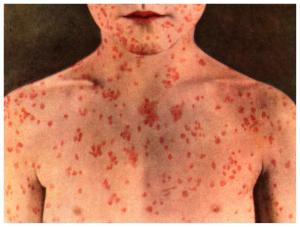Up to now I had avoided wading into the subject of immunization safety. It’s such a large topic and so fraught emotionally that I thought it would be difficult to do any justice to it in this short space. But the recent events in California demand attention. Please refer here and here for the latest information on the subject. I encourage you to pay particular attention to statistics on the rate of infection and complications from this disease pre and post introduction of measles immunization (1963). Because “one picture is worth 1,000 words”(in this case 2) you can get a little sense of how bad measles can be below:
(above pics from en.wikipedia.net and http://www.soft.org)
Measles is one of the most infectious illnesses know to mankind. One measles patient can infect 12-18 others compared to 1 flu patient infecting 4 others and 1/2-3 for Ebola(remember the fevered stories about the dangers of Ebola spread from just a few months ago?) And measles is severe–1/3 of measles cases will result in serious complications like pneumonia or encephalitis.
And another very important point about the current measles outbreak in California: 17 of the infected people (from as far away as Mexico) had no contact with Disneyland. So consider how easily that indicates that the disease can spread. Now check out this picture:
(above from www.richardbradley.net)
This is a polio ward from prior to the licensing of the modern polio vaccines. All of those children are in “iron lungs”–old style ventilators for those who cannot breathe due to paralasis of respiratory muscles and diaphragm. I have never diagnosed polio in my 30 year professional career as there have been no new cases in the Western Hemisphere since 1979. Feel safe in “Fortress America?” Given the spread of measles out west, maybe we shouldn’t.
The eradication of these major infections is a major public health triumph of modern medical science and is responsible for saving millions and millions of lives worldwide. Call me with questions about immunizing your child. By all means, please do your own research online if you wish, but be sure to utilize only reputable websites maintained by fully trained and established experts in the field of childrens’ infections. I recommend the following:
http://vec.chop.edu/service/vaccine-education-center/vaccine-safety/vaccine-safety.html
Thanks for following.



